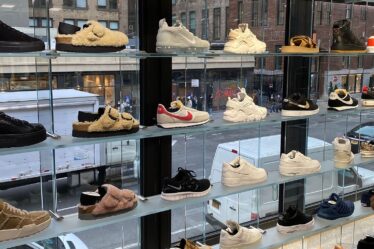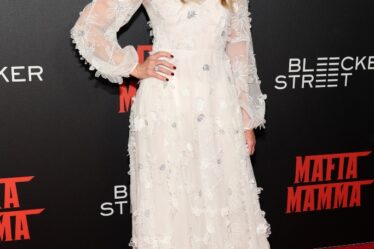PARIS, France — “In a way I do feel like I’ve got myself into a trap.” Rei Kawakubo hesitates, absorbed in thought, troubled. “But I can’t stop.”
Troubled? Maybe tortured is closer to the truth. Talking about her work has never come easily to Kawakubo. Her notorious reticence now seems like the truest complement to the difficulty of the work itself, the business, Comme des Garçons, which she started in Tokyo nearly half a century ago.
It was initially a pragmatic means to an end. Kawakubo was supporting herself by working as a stylist, but she couldn’t find any clothes she wanted to use on her shoots. So she decided to design her own. “I established the company on the premise of trying to always find something that didn’t exist, something new.” That has been the kachikan — the underlying value system or soul — of Comme des Garçons, for 48 years. And it has been Kawakubo’s struggle for almost as long. “Because I’m the kind of person who decides something and sticks to it, I started with that premise and carried on, and through the doing of it, without wavering from the kachikan, it became more difficult. The more I did it, the more people expected it, and the more experience I had, the harder it was to find something. But I could never change that thing, because then it wouldn’t be Comme des Garçons. I had no idea it was going to be like that. I didn’t say, ‘I’m going to have a career that gives me lots of suffering and pain.'”

Rei Kawakubo loves punk. Scan her career and the punk spirit of DIY defiance crops up over and over again. So it’s a part of the essential paradox of Comme des Garçons that she has stuck so hard and fast to the rules of the fashion industry. Season after season, decade after decade, she has shown a collection for spring, a collection for autumn; womenswear and menswear. And it just gets harder. She of all people could break the mould, like her peer Azzedine Alaïa. Show when she wanted, maybe even drop a season if she so desired. But Kawakubo is convinced that if she stops, she’ll never be able to start again. “I’ve never see a person who took time off and came back even stronger than they were,” she says. “That’s definitely true with fashion.” Besides, she insists, the diktat of the fashion calendar is a necessary discipline for her. “Next time, next time… if I don’t keep asking myself when I have to do the next one, then I won’t be able to do it.”
On this particular morning, in the Paris offices of Comme des Garçons, Kawakubo is attended, as always, by Adrian Joffe, her husband of 26 years and president of the company. Clearly sensitised to her hesitant, muted mode of speech, he is her translator. And, like all those who are close to Kawakubo, he can confirm that the creative process is acutely painful for her. The pain only subsides when she is actually making something. “That seems to be the way it is,” she agrees. “I’m never sure, even up to the minute before the show, how it all hangs together. There’s never a moment when I say, ‘OK, I’ve done it.'”
Maybe it could never have been any different. Quick, choose three words that define Comme des Garçons. Mine would be: zero, new, freedom. Zero is where Kawakubo always starts in her pursuit of something new, something that doesn’t already exist, and freedom is obviously necessary for her quest. But freedom has two faces — freedom from and freedom to, the burdens attached to both defined for the ages by the influential psychoanalyst Erich Fromm, whose masterwork “Escape from Freedom” rings as true now as it did in 1941 when he wrote it under the stormclouds of Nazism. For Fromm, freedom was identical with doubt, and genuine free thinking provoked anxiety. Obviously, he never met Rei Kawakubo, the most free-thinking of all fashion designers, but she certainly embodies his theory.
Kawakubo’s most immediate source of anxiety is “Art of In-Between,” the exhibition which opens at the Metropolitan Museum of Art in New York on May 4. It’s only the second time in the 70-year history of the museum’s Costume Institute that there has been a show dedicated to a living designer. And it’s the first time Kawakubo has agreed to put her name to such an endeavour. Why now? “Good timing,” she replies succinctly. More of that later.

She’s never had any interest at all in revisiting her past, so the thought of a traditional retrospective was anathema to Kawakubo. When head curator Andrew Bolton originally approached her, she wanted the exhibition to focus only on the past four years, the eight collections she has shown for women since Spring/Summer 2014, when she changed everything for Comme des Garçons. At the time, Kawakubo had hit a wall. Going back to zero yielded no dividend. She craved an alternate consciousness, any consciousness as long as it wasn’t hers: outsider artists, autistics, schizophrenics, psychonauts… “How do I get out of my head?” she demanded of Joffe. The option of making herself mad not being a particularly viable one, Kawakubo came to this conclusion: I won’t even try to make clothes. “Not Making Clothing” was the name she gave that Spring/Summer 2014 collection. Not making “clothing” is what she has been doing ever since, with a procession of shows that have subverted to transcendent effect the familiar forms and functions of fashion. “It was the only way I could continue to do what I wanted,” she insists.
By that same token, it was the only way she could imagine doing a museum show. “But the whole thing developed further from that and became something a little different,” Kawakubo concedes. “I was not so happy at first. I never wanted to do a retrospective, and it ended up like that. There was give and take. It’s a Met show for Comme des Garçons, not a Comme des Garçons show at the Met. Compromises were made. The most important point was we finally agreed to compromise on showing old things.” The deal that was struck was that Bolton would get to curate his “old things,” Kawakubo would get to create a museum exhibition “in a way it’s never been done before. I didn’t want to show clothes in someone else’s space.”
I never know at any given time whether I’ll even be able to do the next collection. It’s very painful.
The essential publication that accompanies “Art of In-Between” features some tantalising renderings of Kawakubo’s maze-like exhibition space in its virgin state. It illuminates the concepts of mu (emptiness) and ma (space) defined by Bolton in his introduction as fundamental to Comme des Garçons, along with the idea of wabi-sabi, the Zen Buddhist appreciation of asymmetry, irregularity and imperfection. When he outlined these lyrical parameters at a preview of the exhibition in Paris in January, I assumed Bolton was channeling Kawakubo. “I understood most of what Andrew said,” she counters. “Some I agreed with, some I didn’t. I knew from the process of working with the Met it would be like that. The point of the curator is his interpretation which we allowed him to have. We trust in him. He trusts in us.” She once said she preferred the notion of “conspiracy” to “collaboration.” “To go underneath and turn something upside down” is the way she described it to me. In the book, there is a transcription of a conversation between Kawakubo and Bolton that offers some stimulating insight into the extent — and the limitations — of their conspiracy.
You can only imagine the to and fro. Kawakubo would be a formidable combatant. And that’s why her insecurity is such a surprise. “Are you sure people who don’t know Comme des Garçons will come?” she wonders about the Met show. “I don’t expect anybody to come.” I remind her of the massive turnout for the museum’s Alexander McQueen extravaganza. “Didn’t they know McQueen more?” No, not at all. On my visit, I’d talked to an elderly couple from Hawaii who’d been drawn in by the museum and entranced by the exhibition. And so it will surely go for Comme des Garçons. “A new audience?” Kawakubo muses. “That might be the point of doing it at the Met. I would hope to teach some of those people a new aesthetic, that there are different ways of looking at beauty, other values that can be valid.”

There’s a similar tentative note when she talks about her last show, “The Future of Silhouette,” in which sculpted shapes, simultaneously primordial and futuristic, moved warily around a raised pink stage under artfully strung spotlights. It felt more…theatrical… than Kawakubo’s usual presentations, which are resolutely floor-level with no extraneous flimflam. Joffe explains that more people wanted to come because of the Met, and that necessitated a stage, so that they would all be able to see. Kawakubo reluctantly complied, but made sure the stage was an original shape (triangular). And pink, “to make it more beautiful.” And, 10 minutes before showtime, she instructed her models to use the whole stage, “to be aware of each other, have some communication. You can’t really express much when you’re just walking up and down.” As usual, just what that expression might be was refracted through a multitude of interpretations. “Was it a good meaning?” Kawakubo flickers uncertainly. She has no idea. “I never know if the last one’s been successful till I start the next one. It’s very hard for me to judge. I never know at any given time whether I’ll even be able to do the next one. It’s very painful.”
Pain, again. That may well be the condition of an ethos which took shape in the uncharted zone of the “In-Between.” Bolton’s curation is a set of polarities: Fashion/Anti-Fashion; Design/Not Design; Then/Now; High/Low; Self/Other; Object/Subject; Clothes/Not Clothes. Any effort to reconcile them is sufficient to simulate the anxiety that has maybe underpinned Kawakubo’s career from the start. Inevitable really, when her company, founded on a quest for financial independence, was always a delicate balance of her wants and needs, of creativity and commerce.
“It’s a contradiction,” she acknowledges. “I want to give myself the freedom to always find something new but at the same time, I want to have a successful business where I can grow and pay the people and look after the factories and get more staff.” So the impossibility of stopping is not just about disappointing people who expect — who need — her vision. It’s also about her commitment to the spiritual and physical wellbeing of everyone who works for her. More of that essential paradox: the radical vision hand in hand with one which is traditional, maternal. She could be “Mamma Rei, the matriarch” if it weren’t for her antipathy to any conjecture that is gender based. (When I ask if the pain she talks of might be connected to a particular female creativity — the pain of giving life? — she says, “I don’t think it’s any relation to that. There are lots of men who give birth to ideas.” Her business is comme des hommes.)
So maybe I’ll cast Kawakubo in a more tribal light, something along shamanistic lines. It suits the spiritual dimension of Comme des Garçons. The most profound polarity is Life/Death. Spirits move in the space between them. According to its folklore, Japan is one of the most haunted places on earth. Every human being houses a reikon, a powerful spirit which is released at death. This digression on my part unsurprisingly gets short shrift from Kawakubo, but I still feel there’s some subliminal connection with the “Art of In-Between.” It’s in the way she works, not there in front of you, but somewhere behind, somewhere around. Ghostly.

The audience for “Art of In-Between” will undoubtedly include thousands for whom Rei Kawakubo’s insistence on her fundamental ordinariness will seem perverse in the context of her extraordinary body of work. She would hardly be the first artist who was preconceived by her art. But you can glean a reassuringly human portrait of the woman from decades of commentary. She loves animals and architecture, good food, travel, hot springs. Her fondness for movie directors like Tarkovksy, Angelopoulos and Pasolini — complicated, dark — isn’t a surprise. Her love of slapstick humour is. She likes to read biographies. “She’s almost interested in politics,” adds her husband. And Kawakubo’s respect for tradition, her admiration of authenticity are obvious in her love of uniforms, which has been a constant in her collections. She’s created her own uniform pieces too. The Aoyama bag has been on shelf for 20 years.
And yet, each new season is Kawakubo’s invitation to agony as she sets herself the impossible challenge of exploring the in-between yet again. “Someone trying to measure infinity” was journalist Robin Givhan‘s memorable summation of Kawakubo. Which raises the urgency of time, the issue of ageing for a designer in her mid-seventies at the helm of a multi-tentacled business that generates revenue of over $280 million a year. There are now more than a dozen collections that carry the Comme des Garçons label, along with the burgeoning multi-brand retail business Dover Street Market. “We’ve been growing so quickly the last few years,” says Joffe. “The only way to grow is horizontally, because Rei is very aware that the market is limited for the main line.” He also believes the other brands, the other designers under the Comme des Garçons umbrella — like Junya Wantanabe and Noir Kei Ninomiya — will ensure the company thrives into the future, even as he knows there can never be another Kawakubo.
Meanwhile, she still has her eye on every detail of her empire. If she has given the designers in her stable creative freedom, she is engaged in every other element of their strategies. But, Joffe says, she is also preparing for a world without Rei. Met show notwithstanding, her own legacy matters less to her than the future wellbeing of her company.
But still, there’s that answer she gave me: “Good timing.” You can appreciate Kawakubo’s nervousness about “Art of In-Between.” Swansong? Lifetime achievement gong? No. The impossibility of stopping, remember? She has spent decades raising people’s expectations, then torturing herself as she tried to meet them. As one definitive statement about exactly what it is Kawakubo’s been doing all these years, the Met show functions as a glorious exercise in expectation management. Perfect timing. If it’s impossible for her to stop, she will at least now be free from… Hopefully that will make her free to… The trap opens.



